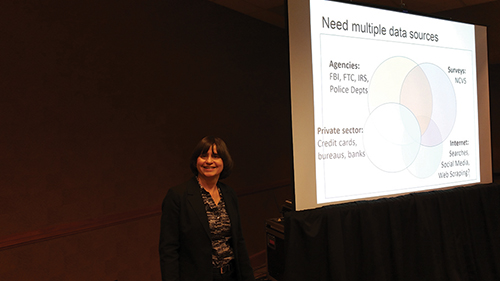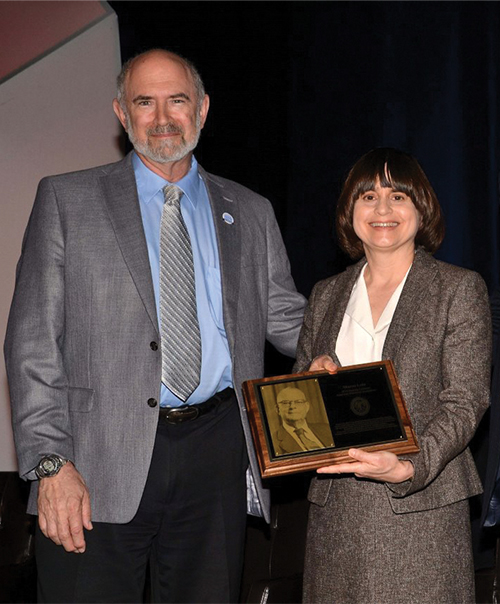Sharon Lohr Shares Unique Path to Writing About Crime
Debbie Sniderman, VI Ventures LLC

Sharon Lohr gives a talk about statistical methods for combining data at the 2018 conference of the American Association for Public Opinion Research.
Sharon Lohr was the first (and still only) female Deming Lecturer. She is a Fellow of the American Statistical Association, an elected member of the International Statistical Institute, and the inaugural recipient of the Gertrude M. Cox Statistics Award for contributions to the practice of statistics.
When she was young, Sharon Lohr’s father would wake her up to watch the Apollo launches. He sold hydraulic equipment and was proud that one of his systems ended up being used in the Gemini program.
She followed her father’s example, reading everything that came her way. She especially loved science fiction and Robert Heinlein books, in which the admirable characters shared a love for and determination to excel in mathematics.
Lohr says there were many challenges in her career, but also many good people along the way. Finishing college was a significant turning point in her life. Her mother thought girls didn’t need to go to college, and Lohr was only allowed to attend after her father promised she would study music. So during her first year at Calvin College, Lohr studied piano, but also took electives in calculus and chemistry.
When her father suffered a disabling stroke during her freshman year, Lohr’s mother wanted her to quit college. Her best friend’s parents insisted she finish and helped her find a way to do so. By combining Social Security benefits, her savings from working during high school, and earnings from working full time during the academic year and multiple jobs in summers, she was able to graduate debt free while still helping out financially at home.
Entering Statistics
Lohr first encountered statistics during her senior year and credits her undergraduate adviser, Thomas Jager, for steering her toward it in graduate school. “He suggested I apply to statistics programs because I had done well in real analysis and wanted to learn about lots of different things,” she says. “Even though I didn’t really know what statisticians did, it sounded interesting, so I applied to graduate statistics programs.”
Jager also recommended Lohr for a summer internship at NASA Goddard Space Flight Center. For someone who grew up reading Heinlein and following the space program, working at NASA was a dream come true.
At NASA, Lohr worked on a project to improve the spatial resolution of numerical weather predictions. Calculations for a forecast often completed after the weather occurred due to the the computer power of the time. Lohr modified front-end computer code so calculations could be sped up by the new CYBER 205 high-speed vector processor. “Figuring out how to vectorize everything and seeing applications of math, science, and statistics was interesting and fun,” she says.
Lohr pursued her PhD at the University of Wisconsin-Madison and, in her first course—Statistical Experimental Design for Engineers—encountered William G. Hunter, who became one of her many mentors. She enjoyed his practical experience solving problems, designing experiments, and working with clients She also got from him a picture of what a statistician should be. At Madison, she also had the opportunity to meet W. Edwards Deming.
Launching a Career from a Workshop
Lohr began working on survey sampling and crime statistics through a chance opportunity. Her dissertation was in sequential analysis, but as a new faculty member at the University of Minnesota, she was assigned to teach the sampling class. When a colleague told her about a summer workshop on the National Crime Victimization Survey sponsored by the Bureau of Justice Statistics, she jumped at the chance to learn more about sampling to help make the subject come alive for her students.
The workshop ended up changing her career path. Seeing the problems BJS and the Census Bureau faced in conducting a survey about crime, the ingenious solutions they came up with to solve them, and the steps they took to continually improve their surveys planted in Lohr the desire to work on these problems herself.
Academic Research
Lohr joined Arizona State University as part of a two-career couple. While teaching classes and working toward tenure, she wrote numerous research articles and turned her sampling notes into her first book: Sampling: Design and Analysis. It was at this time that advice from Lynne Billard and colleagues in the first Pathways to the Future workshop helped her tremendously.
Lohr began a long-term collaboration with Jon Rao in 1996. She calls him one of the truly great statisticians of our time, with a gift for anticipating what the important research problems will be 20 years from now and solving them in the present.
After 25 years of working in academia, Lohr visited Westat to work on a crime survey that could be conducted by mail. She was subsequently invited to join the company as vice president. She enjoyed developing survey designs and statistical analysis methods for applications in transportation, public health, crime measurement, and education over the next five years.
Writing About Crime Statistics
Having mostly written technical articles for statistics journals, Lohr finds writing for popular audiences to be a new challenge. Her forthcoming book, Measuring Crime: Behind the Statistics, is a guide for nonstatisticians on how statistical reasoning applies to crime statistics.
Lohr tells where crime data come from, how the data become statistics, and how to judge the quality of a crime statistic in a newspaper. She also tells stories about how statisticians have solved problems of measuring aspects of crime and improving the statistics.
“It’s written as a general book for anyone interested in crime or statistics: students, policymakers, journalists, and interested citizens,” Lohr says. “As part of the ASA series on Statistical Reasoning for Science and Society, it will emphasize how central statistical thinking is to basically everything we do.”

Sharon Lohr joins Jon Rao on a tour during the 2009 Conference on Small Area Estimation in Elche, Spain.
Advice for Others Interested in Getting into Statistics
To young statisticians, Lohr advises to not plan life rigidly. “Doing so can lead to disappointment when things don’t work out exactly as planned,” she says. “Instead, be open to opportunities that come along. You may not think you want to work in a new area at first, but learn about it and give it a try. It may turn out to be your true calling.”
Her next piece of advice is to learn about designing experiments and surveys. “Some areas of statistics are devoted to fixing things that go wrong,” she says. “Persons in design can set up the study so researchers and policymakers get the information they require without needing heroic data analyses.”
She also advises engaging in activities other than statistics once in a while. For Lohr, it’s music. She’s the only person she knows who paid for her math degree in part by playing piano. “Being a vocal accompanist was a good background for becoming a statistician, since you need to have the same sort of ability to collaborate and to anticipate what other team members will do or need,” Lohr says. “It also gave me a lifelong love of opera.”
“Life is short. Take advantage of opportunities to learn new things and grow,” says Lohr.


















